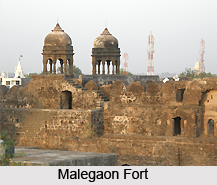 History of Yavatmal district is can be compiled by following the course of events connected with well-known historical sites in the district or near its borders. It is believed that Yavatmal, with the rest of Berar, formed a part of the legendary kingdom of Vidarbha mentioned in the Mahabharata, with the eponymous capital of which Bidar in the Nizam`s Dominions has been identified; and legend identifies the village of Kelapur, which gives its name to one of the talukas of the district, with Kuntalapur, one of the cities of Vidarbha. However the identification of sites in this kingdom is based mostly on conjecture, as a connected history of the district is rather difficult to put together.
History of Yavatmal district is can be compiled by following the course of events connected with well-known historical sites in the district or near its borders. It is believed that Yavatmal, with the rest of Berar, formed a part of the legendary kingdom of Vidarbha mentioned in the Mahabharata, with the eponymous capital of which Bidar in the Nizam`s Dominions has been identified; and legend identifies the village of Kelapur, which gives its name to one of the talukas of the district, with Kuntalapur, one of the cities of Vidarbha. However the identification of sites in this kingdom is based mostly on conjecture, as a connected history of the district is rather difficult to put together.
Berar formed part of the empire of Ashoka, who reigned from 272 to 231 B.C. The kingdom gained independence before the disruption of the Maurya Empire. This was due to the leadership of a local cheiftan who, towards the end of the reign of Pusyamitra Sunga, commanded the forces of Brihadratha, the last of the Mauryan kings. Having slain his master, he established an independent dynasty with its capital at Vidisa, the modern Bhilsa. Agnimitra, his son, found it necessary to make war on his neighbour, the Raja of Vidarbha. The latter was defeated, and the Wardha River was made the boundary between the two kingdoms. There is no indication of the dynasty to which this Raja of Vidarbha belonged to, or of the extent of his dominions.
It is unnecessary, in considering the history of the Yavatmal District, to trace the connection of the Andhras, Sakas, Pahlavas and Yavatmal with Berar. However it is practically certain that the district with most, it not the whole, of the rest of the Province, formed part of the dominions of the Vakataka dynasty. Of this line of kings little is known. A short inscription in Cave XVI at the famous Ajanta caves gives the names of seven members of the Vakataka family, and from other sources we know that ten Rajas, the names of all of whom, save one, have been handed down, ascended the throne. The first was Vindhyasakti.
The Chalukyas and the Rashtrakutas have left no monuments in the district. In the latter half of the tenth century it was included in the kingdom of Vakpati II, Munja, the Raja of Malwa belonging to the Paramara dynasty, whose dominions stretched southwards to the Godavari River. But about 995 A.D., Taila II defeated and captured the Raja of Malwa, and Berar thus fell once more under the sway of the Chalukyas. Towards the end of the twelfth century the Yadavas of Devagiri seized most of the northern districts of the Chalukya kingdom, but it may be doubted whether the whole of the Yavatmal district was annexed by this dynasty. The eastern tracts were probably occupied by the Gonds, whose power in the neighbourhood of Chandrapur seems to have waxed as that of the Chalukya dynasty waned.
In 1853 the district was assigned, with the rest of Berar, to the British East India Company. No disturbance took place within it limits during the Mutiny, and its history since that time has been uneventful, consisting merely of a record of steady progress.
On its assignment to the British, Berar was divided into the two districts of East and West Berar, with their headquarters at Amravati and Akola respectively. The Yavatmal district, with the exception of the Pusad taluka, was included in the former, but in 1864 the taluka of Yavatmal, Darwha, Kelapur, and Wani were formed into a district termed at first as South east Berar, and later as Wani. The assignment terminated in 1903 when Berar was leased by the Nizam to the Government of India, and was transferred from the administration of the Resident at Hyderabad to that of the Central Provinces. In 1905, after the lease, the six districts of Berar were reconstituted and Wani received from the Basim district the taluka of Pusad. The name of the district was at the same time changed from Wani to Yavatmal.



















